Medieval & Renaissance Manuscripts
When Pierpont Morgan acquired his first medieval manuscripts at the end of the nineteenth century, he laid the foundation for a collection whose quality would rank among the greatest in the world. Since Morgan's death in 1913, the collection has more than doubled. Spanning some ten centuries of Western illumination, it includes more than eleven hundred manuscripts as well as papyri. To this should be added the Glazier, Heineman, Bühler, Stillman, and Wightman manuscripts, which include more than two hundred more items. Although the collection was formed to illustrate the history of manuscript illumination and includes significant masterpieces from the ninth to sixteenth centuries, there are also some important textual manuscripts.
The Morgan's collection is made up primarily of Western manuscripts, with French being the largest single national group, followed by Italian, English, German, Flemish, Dutch, and Spanish. There are also examples of Armenian, Syriac, Coptic, Ethiopian, Arabic, Persian, and Indian manuscripts. More than fifty Coptic manuscripts from Hamouli, Egypt, nearly all of which were found in their original bindings, form the oldest and most important group of Sahidic manuscripts from a single provenance, the Monastery of St. Michael at Sôpehes.
The majority of these books are of a religious nature, but the collection also includes important classical works, scientific manuscripts dealing with astronomy and medicine, and practical works on agriculture, hunting, and warfare. Notable are the ninth-century bejeweled Lindau Gospels, the tenth-century Beatus, the Hours of Catherine of Cleves, and the celebrated Hours of Cardinal Alessandro Farnese, the best-known Italian Renaissance manuscript.
Lindau Gospels
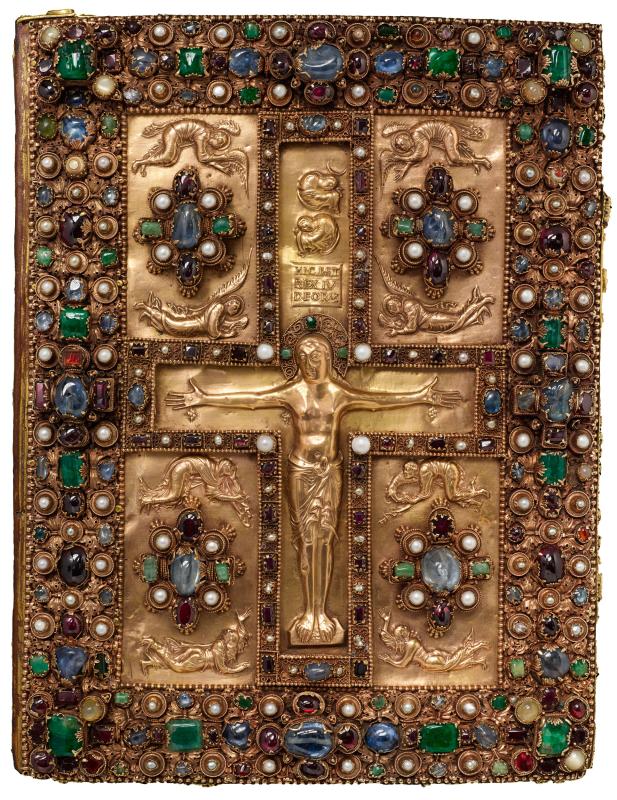
Gospel book; written and illuminated in the Abbey of St. Gall, Switzerland, 880s to 890s.
Scribe: possibly Folchard, who also may have been the artist.
Decoration: four title and four incipit pages in gold on vellum stained purple; twelve canon tables on purple backgrounds, lettered in gold and silver; 2 carpet pages.
Gospel Book

Ms. Gospel book; written and illuminated in Reims, France, probably at the Abbaye de St-Remy (the Abbey of Saint-Remi), ca. 870s.
Decoration: written in gold; 4 full-page Evangelist portrait miniatures; 4 illuminated incipit pages; 1 decorated canon tables.
Nees, Frankish Manuscripts, vol. 2, 294, sees formal similarities to works in ivories commissioned by or around Hincmar in the 870s, including the cover of the Pericopes of Henry II (Munich, Clm. 4452). Some of the decoration shares similarities with New Haven, Beinecke M 413, created in Reims probably in 873-877.
At the end of the volume, there are three flyleaves, originally from a sixteenth- or seventeenth-century lectionary, including readings for Easter, Pentecost, Christmas, Holy Sacraments, St. Remigius, dedication of a church, and Assumption. Front flyleaf and last flyleaf are from a book of homilies of Pope Leo, written in the fourteenth century.
Livre de la chasse
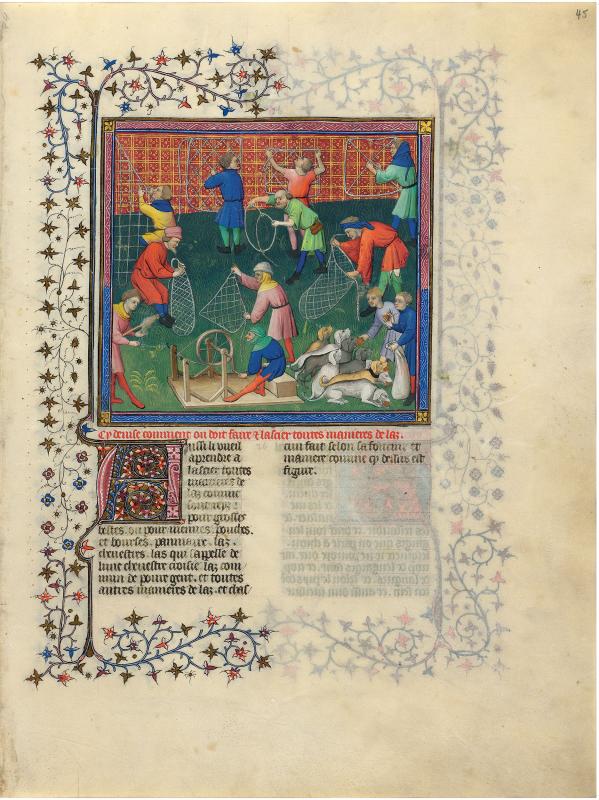
Text written in 1387-1389 by Gaston III Phœbus (Phé́bus or Febus), Count of Foix (1331-1391) and dedicated to Philip the Bold (1342-1404). Folios 111-126 contain prayers in French and Latin.
Ms. written and illuminated in Paris, France, ca. 1406-1407.
Decoration: 87 large miniatures, 1 added armorial frontispiece, 1 full border, numerous illuminated initials with border extensions.
Artist: Although usually designated Bedford Trend, Eberhard König believes that the Bedford Master himself worked on the manuscript after another illuminator, perhaps the Josephus Master, had devised the subjects. (The Josephus Master, a follower of Jacquemart de Hesdin, was a French illuminator (and painter?) who was named after the two miniatures he contributed around 1415 to a manuscript of Josephus' History of the Jews (Antiquités judaïques) commissioned by Jean, duc de Berry (today in Paris, BnF, MS fr. 247). He was baptized by Millard Meiss in his monograph on the Limbourg brothers in 1974.)
Revised: 2015
Antiphonary

Ms antiphonary single leaf; initial A; illuminated in Italy, probably in Florence, ca. 1280; antiphon text and musical notation on verso added in the 16th century.
Decoration: 1 full-page historiated initial with 3-register Last Judgement composition; framed with an ornamental chain border.
Artist: Maestro Geometrico, who is also known as Maestro Terzo.
Antiphonary

Ms. antiphonary for the Feast of Corpus Christi through the 24th Sunday after Pentecost, use of Rome; written and illuminated in Milan, Italy, ca. 1470-1495.
1 of 6 (with M.683-M.687) choirbooks commissioned by Carlo Pallavicino, Marquis of Cremona, Bishop of Lodi. (1456-1497), for the Cathedral of S. Bassano at Lodi, Italy.
Decoration: 4 large historiated initials; 1 large decorated initial, 1 ornamental border with 8 medallions.
Artist: attributed variously to Francesco da Castello (Francesco Bettini), Venturino Mercati, and others, including artists from the circle of the Master of Ippolita Sforza.
Musical notation: 4-line staves with square notes, 5 staves to a page.
Antiphonary

Ms. antiphonary single leaf (cutting); written and illuminated in Bologna, Italy, last quarter of the 15th century.
Musical notation: on verso, three 4-line staves drawn in red ink; neumatic notation.
Decoration: 1 historiated initial A (the Resurrection); Italian Renaissance style.
Artist: Domenico Pagliarolo; signed on top of the initial A: Dominicus Bon.
Worksop bestiary

Ms. bestiary; written and illuminated in England, possibly in Lincoln or York, ca. 1185.
Texts: De imagine mundi (fol. 2-7); bestiary; Pseudo-Augustine, Sermo de beato Joseph (fol. 118-120v).
Decoration: 106 miniatures of various sizes.
Bestiary
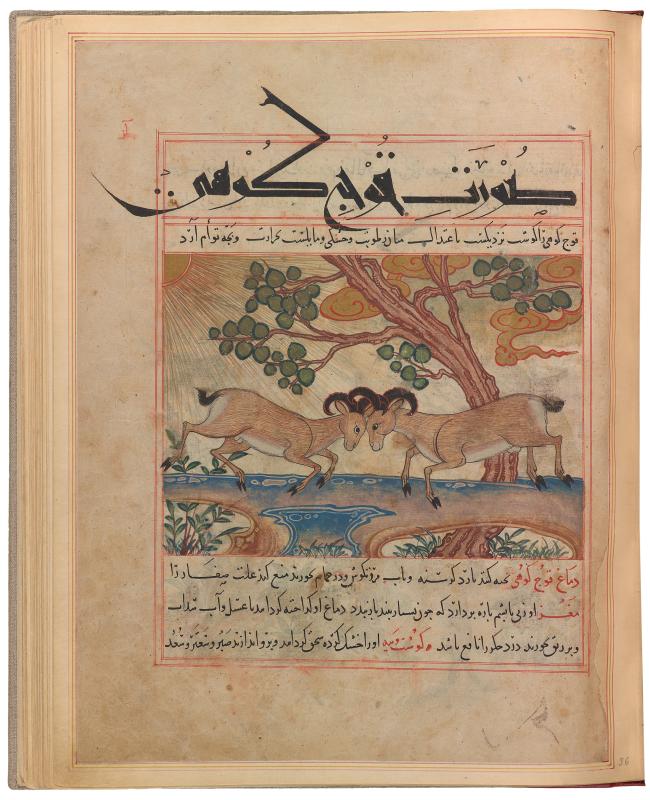
Ms. translation from Arabic into Persian; written and illuminated in Maragheh, Iran, on the 11th of ... 600 and 90 (i.e., either 1297-1298 or 1299-1300).
The translation is by ʻAbd al-Hādī ibn Muḥammad ibn Maḥmūd ibn Ibrahīm al-Marāghī, which he made at the command of Ghazan Khan, the Mongol ruler of Iran (ruled 1295-1304).
Dated in the colophon on fol. 84v.
During a 19th cent. or early 20th cent. restoration, considerable inpainting and overpainting was done, and new miniatures were added. These are on folios 3v, 6v, 23v, 25v, 36r, 47v, 58v, 72v, 78r, 78v, and 84r.
Decoration: wove paper which ranges from thin to medium thick; text written in black ink with important words in red ink; illuminated heading on fol. 2 written in white muḥaqqaq on a lapis background; illuminated shams (sunburst) medallion with the name of the patron on fol. 2r; 103 miniatures; text and some miniatures are framed by two concentric red lines; other miniatures have gold frames; following fol. 60 headings are written in Arabic rather than Persian.
The illumination of M.500 is unfinished. On fol. 83r a blank space was left for a miniature, which was never painted.
Manāfiʻ al-ḥayawān
Book of Hours

Ms. book of hours for the use of Rome; written and illuminated in Italy, probably Milan, 1470-1480.
Decoration: 6 full-page miniatures, 12 full-page calendar illustrations, 3 small miniatures, 22 historiated initials with marginal extenders; 2 full-page miniatures and 5 text leaves added in the early 17th century.
Artist: attributed to Venturino Mercati.
Book of Hours

Ms. book of hours, mostly for the use of Windesheim (Hours of the Virgin); written and illuminated in the Netherlands, perhaps in Delft, ca. 1415-1420; an added section (fol. 194-214) which is not illuminated, was composed in Flanders, ca. 1450.
Decoration: 53 full-page miniatures, 7 half-page miniatures, 10 historiated initials, 24 calendar illustrations, border decoration on all text pages; Dutch Gothic style.
Artist: Master of the Morgan Infancy Cycle.
Book of Hours

Ms. book of hours for the use of Sarum (Hours of the Virgin, calendar) and Rome (Office of the Dead); written and illuminated in Belgium, perhaps Ghent, ca. 1420; additions in England, ca. 1420.
Decoration: 30 full-page miniatures, decorated initials, and border ornament.
Artists: Master of Guillebert de Mets and two anonymous English artists.
The English artist responsible for the miniatures of the Passion sequence starting on fol. 53v may be the same as the artist of London, British Library, Harley 4605, as well as Illustrator B in the London Psalter (Victoria & Albert Museum, Ms. Reid 42), whose hand is also found in Pierpont Morgan Library MS M.893; the second English artist, responsible for fol. 44v, may be the same as Illustrator C of the Victoria & Albert Psalter--Cf. K. Scott, p. 216.
Book of Hours
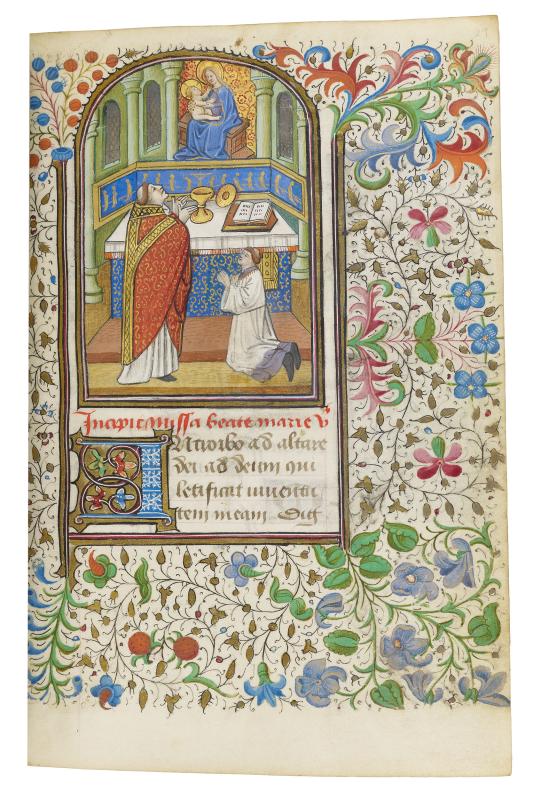
Book of hours for the use of Rome; calendar in French; written and illuminated in Northern France or Flanders, ca. 1445.
Decoration: 25 miniatures, most with border scenes, and 2 historiated initials; kneeling owner portrait on fol. 21 with the enthroned Virgin; miniatures appear to have been repainted in the 19th century.
Artists: a follower of the Master of Guillebert de Mets and a follower of the Egerton Master.
Book of Hours

Ms. book of hours for the use of Paris; written and illuminated in France, perhaps in Paris or northeastern France, ca. 1465.
Decoration: 16 large miniatures, most with border medallions; 24 calendar illustrations; full borders on most of the leaves; a missing leaf from this ms. depicting God the Father Enthroned, was in the Catalogue Handzeichnungen, C.G. Boermer in Leipzig, May 9 and 10, 1930, no. 254, from the Spitzer Collection; then sold in Kornfeld und Klipstein, Bern, Auktion 114, June 15, 1955, no. 52; its present whereabouts are unknown.
Four miniatures are missing on fols. 14r-15r, 24r-25r, 97r-98r, 217r-218r.
Artist: Master of Jacques de Luxembourg.
Book of Hours

Ms. book of hours for the use of Rome (Hours of the Virgin); written and illuminated in Bruges, Belgium, ca. 1520.
Decoration: 27 full-page miniatures, 12 calendar miniatures, 2 historiated borders, and 8 borders with genre scenes.
Artist: Simon Bening.
Book of Hours

Ms. book of hours for the use of Rome (Hours of the Virgin; manuscript lacks calendar, Office of the Dead, litany, and Suffrages); written and illuminated in Tours, France, ca. 1515.
Decoration: 8 full-page miniatures, 96 text pages bordered with flowers, fruits, and various plants, each identified by name in Latin and French.
Artists: Jean Bourdichon and an anonymous mid-sixteenth-century Italian illuminator who painted the Madruzzo arms and emblems on fols. 2v, 3r, 61r, 61v.
Bourdichon's full page illustrations and botanical borders are very close to his work in the Hours of Anne de Bretagne (Paris, Bibliothéque nationale, Lat. 9474).
This may be the book of hours Bourdichon finished in 1518 for François 1er after working on it for four years (see Nicholas Herman, "'Ut certius et melius ipsum depingeret': Observations sur la production et l'activité tardive de Jean Bourdichon," Peindre en France à la Renaissance: 1, Frédérick Elsig ed., 2011, p. 223).
Revised: 2015
Hours of Catherine of Cleves
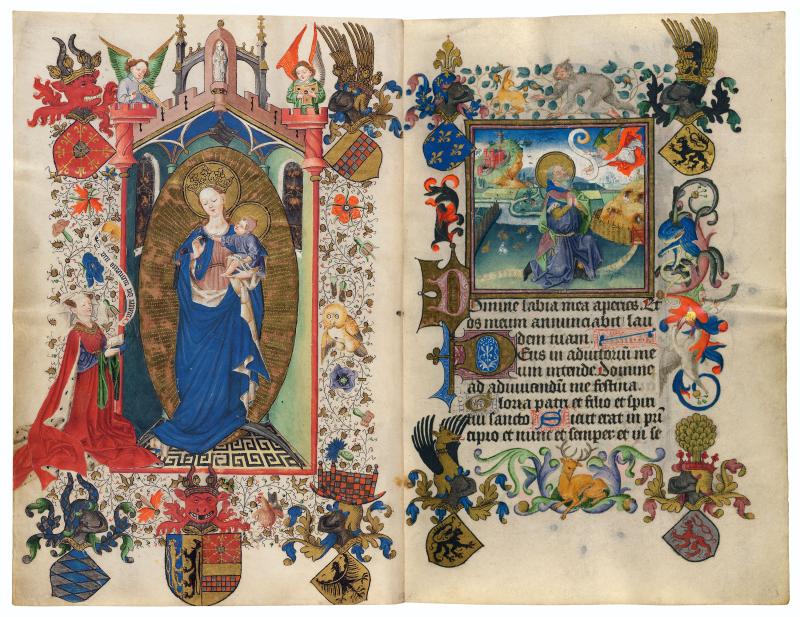
The Hours of Catherine of Cleves is the greatest Dutch illuminated manuscript in the world. Its 157 miniatures are by the gifted Master of Catherine of Cleves (active ca. 1435-60), who is named after this book. The Master of Catherine of Cleves is considered the finest and most original illuminator of the medieval northern Netherlands, and this manuscript is his masterpiece.
The manuscript Catherine commissioned is a prayer book containing an unusually rich series of devotions illustrated with especially elaborate suites of miniatures. The artist's keen sense of observation combined with an interest in everyday objects was a style far ahead of its time (it would come to flower in seventeenth-century Dutch still-life painting). All the miniatures are filled with amazing detail. Narrative was also one of the great talents of the Master of Catherine of Cleves--he could tell a good story. Finally, Catherine's codex is famous for the artist's innovative borders, no two of which are alike.
Ms. book of hours for the use of Windesheim; written and illuminated in Utrecht, the Netherlands, ca. 1440; manuscript separated into two or more parts sometime after its creation; brought together again under common ownership in 1970 (M.917 and M.945).
Pierpont Morgan Library. MS M.917, which was paginated by a previous owner, contains 164 leaves; Pierpont Morgan Library. MS M.945 contains 194 leaves.
Decoration: 10 full-page miniatures, 84 half-page miniatures, decorated initials, border decoration, pen flourishes (M.917); 15 full-page miniatures, 48 half-page miniatures, 1 historiated initial, decorated initials; almost all text pages have elaborate border decoration and pen flourishes (M.945).
Artist: Master of Catherine of Cleves.
Book of Hours

Ms. book of hours for the use of Tournai; written and illuminated in Bruges, Belgium, ca. 1450.
Decoration: 2 full-page and 6 large miniatures.
Artist: the Master of Jean Chevrot executed five miniatures, fol. 13v (Holy Face), 15v (Trinity), 23v (St. George), 25v (St. Nicholas), 27v (St. Adrian); two miniatures are by an anonymous hand.
Some of the miniatures may have been retouched; the Crucifixion on fol. 19v is possibly a 19th-century copy--Cf. PML files.
Book of Hours

Ms. book of hours for the use of Rome (Hours of the Virgin, Office of the Dead); calendar in French; written and illuminated in France, probably Paris, ca. 1460.
Decoration: 29 miniatures; 1 miniature, depicting the Virgin and Child, formerly between fol. 117 and 118, is now owned by The Caramoor Foundation, Katonah, New York.
Artist: a follower of the Master of Jean Rolin (23 miniatures) and a late follower of the Master of the Munich Golden Legend (6 miniatures and the leaf held in Katonah, New York).
Book of Hours
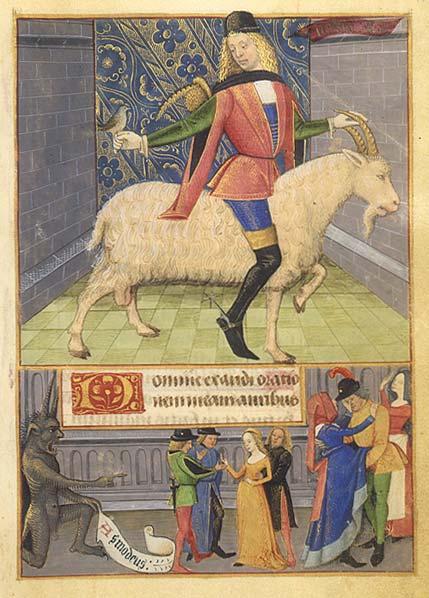
Ms. book of hours for the use of Rome (Hours of the Virgin, Office of the Dead) and Poitiers (calendar, litany); written and illuminated in Poitiers, France, ca. 1475.
Decoration: 38 large miniatures, 20 with border scenes; 1 small miniature, panel borders on nearly every page; includes an unusual cycle of the Seven Deadly Sins to illustrate the Seven Penitential Psalms.
Artist: Robinet Testard.
Revised: 2015
Book of Hours

Ms. breviary or book of hours single leaf; illuminated in Bruges, Belgium, ca. 1500.
Verso is blank with the name F. Locker written at the bottom.
Artist: Gerard David, or Gerard David and another illuminator, or workshop of Gerard David.
Decoration: one full-page miniature depicting the Virgin and child with female saints.
The Virgin among virgins.
Breviary

Ms. Franciscan breviary for the use of Rome (Ordo breviarii, calendar, Hours of the Virgin, Office of the Dead); written and illuminated in Bruges, Belgium, ca. 1500.
Decoration: 25 full-page and 31 small miniatures, 11 continuous historiated borders, 34 border historiations, 51 calendar roundels, 2 calendar demi-roundels, numerous grisaille figures in calendar borders, numerous standing saints in architectural borders on fol. 1v, 140v, 189v, 190v, 375v, 532v, and 533.
Artist: Master of the Older Prayerbook of Maximilian I and the Master of James IV of Scotland, who some scholars identify with Gerard Horenbout.
Commentary on the Apocalypse

St. Beatus of Liébana completed his commentary about 776. The long cycles of pictures accompanying it constitute the greatest achievement of medieval Spanish illumination. The Morgan Beatus is important because it is the earliest complete copy and thus stands at the beginning of the Beatus tradition. Although the book was ordered for Escalada (consecrated in 913), it was not made there, as Maius worked in the tower scriptorium at San Salvador de Tábara, where he died and was buried in 968. Maius tells us he made the book so that the "wise may fear the coming of the future judgment of the world's end."
The Apocalypse, or Book of Revelation, is not only the last Book of the New Testament but is also the most difficult, puzzling, and terrifying. According to the text, it was written on the island of Patmos by a man named John, who, from the second century, was traditionally identified with the "beloved" apostle of Christ and the author of the fourth Gospel.
Beatus was a monk of the Liébanese monastery San Martín de Turieno in northern Spain. He completed his twelve-book Commentary on the Apocalypse about 776. The long cycles of pictures accompanying this commentary, of which about twenty illustrated copies survive, constitute the greatest achievement of medieval Spanish illumination. The present manuscript is the earliest substantially complete copy, dating about 950. The colophon states that it was written and illuminated by an artist-scribe named Maius at the request of Abbot Victor for a monastery of St. Michael. This is probably the monastery at Escalada, consecrated in 913. Maius, however, apparently worked in the scriptorium of San Salvador de Tábara, where he died in 968 and was buried. Although he based his copy on a now lost model, Maius also made important contributions of his own, such as the prefatory evangelists' portraits, genealogical tables, and especially the frames and colored backgrounds. He was regarded by his student as "archipictor," master painter. The manuscript contains 110 miniatures, including some illustrating Jerome's Commentary on Daniel, a second text frequently attached to the Beatus commentary. This text can also be found in the Library's later Beatus, dated 1220.
Following the ominous and threatening depictions of the end of the world comes this representation of the Heavenly Jerusalem as a medieval city, complete with turrets and crenelations. In its twelve gates, topped by horseshoe arches derived from Islamic architecture, apostles stand beneath disks representing the gems that are cited in the biblical text. Within the walls of the city itself are the Lamb of God, the author John holding a book, and the angel measuring the city with a golden reed.
Ms. written and illuminated in Spain, in San Salvador de Tábara, ca. 945.
Texts: Beatus, Presbyter of Liebana, In Apocalipsin (fols. 1-233); Isidore of Seville, De adfinitatibus et gradibus (fols. 234-237); St. Jerome, Commentary on Daniel (fols. 238v-292v); an anonymous discussion of the Apocalypse and comments on Beatus's work (fols. 294-299). According to the colophon (fol. 293) Maius was both the scribe and the illuminator, and executred the work at the command of the Abbot of the Monastery of St. Michael.
Scribe: Maius (died at Tábara in 968)
Decoration: 68 full-page miniatures, 48 smaller miniatures; diagrams, colored initials, and ornaments; Spanish Mozarabic style.
Artist: Maius (died at Tábara in 968)
De materia medica

Ms. herbal; written and illuminated in Constantinople in the mid 10th century.
Alphabelical Five-Book version of Dioscorides, De Materia Medica.
Decoration: 769 illustrations; several headpieces and tailpieces.
Plant and animal identifications are based primarily on Morgan Library notes and Dioscorides, De Materia Medica, trans. Lily Y. Beck (2005). Also consulted: André, J., Noms de plantes dans la Rome antique (1985); Der Wiener Dioskurides: Codex medicus Graecus 1 der Österreichischen Nationalbibliothek, Kommentar von Otto Mazal (1998-1999).
Decretals with the glossa ordinaria

Ms. canon law single leaves written and illuminated in Bologna, Italy, ca. 1330-1335.
Each of the four leaves of M.716 initiates a major division of the Decretales of Pope Gregory IX, with its corresponding miniature: M.716.1 illustrates the Prologue; M.716.2 Book I; M.716.3 Book II; M.716.4 Book III. The location of the opening leaves for Books IV and V, or indeed the remainder of the manuscript, is unknown.
Decoration: M.716.1: recto blank; on verso, 1 2-column miniature, 4 historiated initials, intertextual marginal vignettes; M.716.2: on recto 1 2-column miniature, 1 historiated initial, and historiated intertextual marginal vignettes illustrating the Doctrine of the Trinity and aspects of the Catholic Faith; on verso: 1 small miniature of the Nativity and Annunciation to the Shepherds; M.716.3: 1 1-column miniature, 2 historiated initials, historiated intertextual marginal vignettes; M.716.4: 1 2-column miniature, 2 historiated initials, historiated intertextual marginal vignettes.
Artist: Master of 1328.
Texts: M.716.1: Decretales of Pope Gregory IX, Prologue incipit; M.716.2: Text and gloss of Bernardo Bottoni on the recto continue the prologue to the Decretales initiated on the verso of M.716.1; at the lower right-hand text column is the rubric for the incipit to Book I: De summa trinitate et fide catholica. On the verso, the rubricated incipit is repeated at the top of the left-hand column, and the text for Title 1, Chapter 1 opens Firmiter credimus et simpliciter confitemur. (M.716.2 was originally the recto page of the elaborate double opening for this text with M.716.1, a configuration first devised around the end of the thirteenth century and used by artists working in the Byzantinizing style. The earliest illuminated manuscripts of this text customarily began with the prefacio and its illustration on the recto of the first folio, the decoration for Book I falling on its verso.); M.716.3: Decretales, Book II incipit; M.716.4: Decretales, Book III incipit.
Fables

Ms. written and illuminated in southern Italy in the tenth or eleventh century.
Texts: fragment of the Kalīlah wa-Dimnah (Greek version of the Stephanites and Ichnelates) (fol. 1r-7v); Physiologus (fol. 8-21v); Vita Aesopi (fol. 22-67v); Aesop's fables (fol. 67v-108r); Babrius's Fabulae Aesopeae (fol. 108r-112v); seven Asteia of Hierocles the Grammarian (fol. 112v).
Decoration: 20 unframed colored-drawings and 7 uncolored-drawings.
Farnese Hours
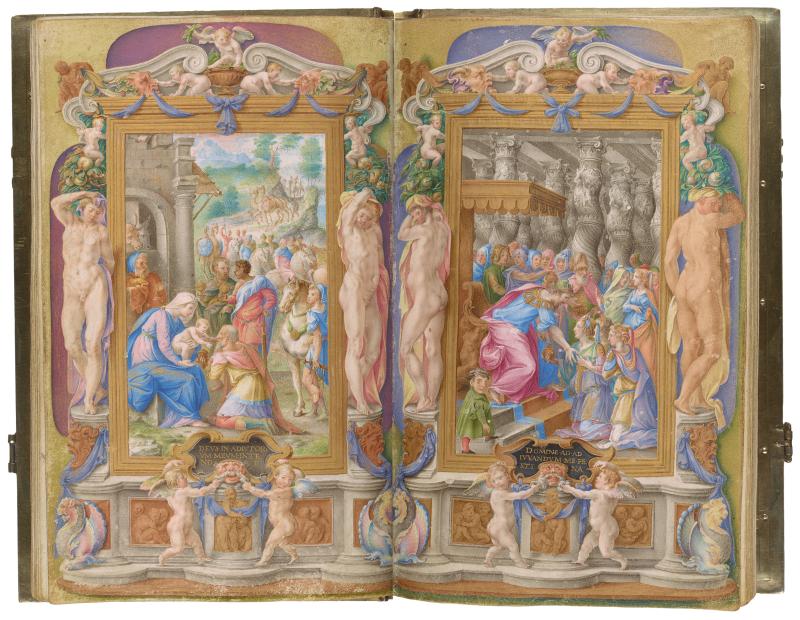
The Farnese Hours, the last great Italian Renaissance manuscript, was highly praised in Vasari's Lives of the Painters (1568). Of Clovio, a Croatian, Vasari said that there "has never been...a more rare painter of little things," calling him a "new, if smaller Michelangelo." Here the bareness of the Adoration of the Shepherds is contrasted with the lushness of paradise. The dramatic light generated by Jesus derives from the Revelations of St. Bridget, as does the motif of the Virgin exposing the Christ child--the shepherds had not been told the child's gender. Many details from the Fall of Man are based on Dürer's famous engraving of 1504.
Originally in limp vellum binding tied with two red silk ribbons; later in Italian early 17th-century silver gilt covers by Antonio Gentili (stored separately as MS M.69a); inside front cover incised with name and arms of Cardinal Alessandro Farnese (1520-1589) and inside back cover incised with name and arms of Cardinal Odoardo Farnese (1573-1626).
Ms. book of hours for the use of Rome; written and illuminated in Rome, Italy; and dated 1546.
Colophon on fol. 112v reads: Iulius. Clovius. Macedo Monumenta Haec. Alexandro. Farnesio Cardinali Domino Suo Faciebat MDXLVI.
Leather envelope holding the bound manuscript reads in full: Officio di Giulio Clovio dedicate all'Eccelentissimo Cardinale Fernese 1546. Libro raro e prezioso, o per dir meglio unico
Scribe: Francesco Monterchi.
Decoration: 28 miniatures of which 3 are double page; elaborate historiated borders.
Artist: Giulio Clovio, a Croatian born artist.
Title on leather envelope: Officio di Giulio Clovio dedicate all'Eccelentissimo Cardinale Farnese 1546
Gospel Book
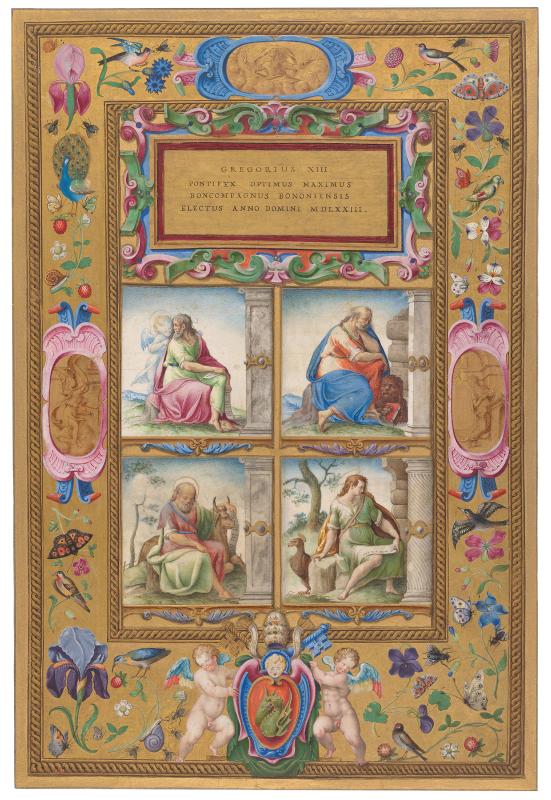
Ms. illuminated montage (single leaf); 6 vellum cuttings consisting of 4 separate miniatures of the Evangelists; a floral border with 3 oval medallions and the papal arms of Gregory XIII, and an architectural cartouche with 19th century inscription, inlaid on a vellum leaf and mounted on cardboard; cuttings of the Evangelist portraits and floral border illuminated in Italy, probably in Rome, during the papacy of Pope Gregory XIII (1572-1585).
A nearly identical example, possibly from the same manuscript or set of manuscripts, is in the collection of the Art Institute of Chicago.
Artist: a follower of Giulio Clovio.
Formerly in blue cloth wrapper in blue morocco case; now matted.
Gradual

Ms. single leaf (cutting) from a gradual; written and illuminated in Milan, Italy, ca. 1500.
Text: on back of miniature is the introit from Epiphany: et potestas et impe(rium) / ps. Deus iudi(cium) / (tu)um regida. et justi(tium).
Musical notation: 4-line staves in red ink, square notes.
Decoration: 1 miniature with the Adoration of the Magi; background of German houses in the miniature are derived from Albrect Dürer's engraving of the Prodigal Son; the castle on the hilltop is derived from his engraving of the Sea Monster.
M.725, cut from a gradual, and M.1090, cut from an antiphonary, probably come from the same set of choir books commissioned for the Olivetan monastery of SS Michele e Niccolò at Vilanova-Silaro (near Lodi).
Artist: Master B.F., sometimes identified as Francesco Binasco.
Miscellany on the life of St. Edmund
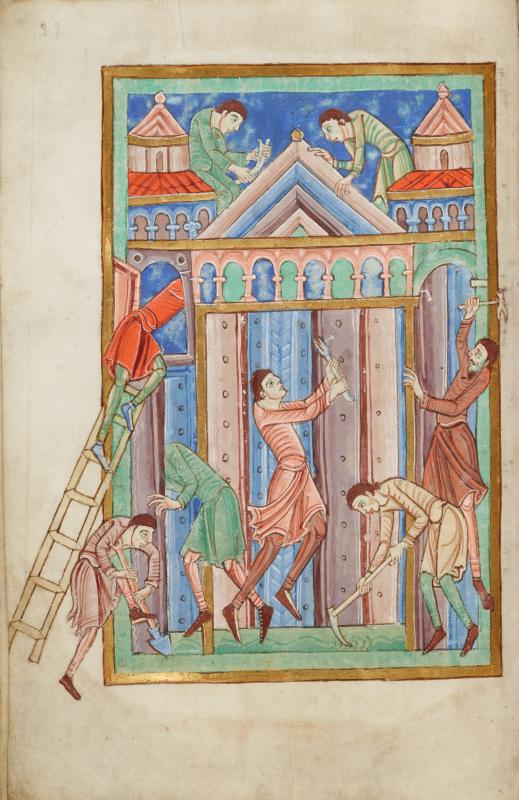
One of the earliest illustrated biographies of an English saint, this lavish volume was a testimonial to patron saint and abbey alike. Most miniatures are based on the passion text of Abbo of Fleury (945-1004); the posthumous miracles depend on Osbert of Clare's text, composed for Anselm shortly before this manuscript was made. In this image, eight thieves are miraculously paralyzed when they attempt to break into Edmund's burial place. The miniatures are attributed to the Alexis Master, founder of the St. Albans school. Named after his St. Alexis cycle in the St. Albans Psalter, he skillfully combined Anglo-Saxon, Ottonian, and Byzantine influences to create England's earliest Romanesque style.
Ms. miscellany on the life of St. Edmund; written and illuminated in the Abbey of Bury St. Edmunds, ca. 1130
Texts: Henry I, King of England, letter to Anselm, abbot of Bury St. Edmunds, forbidding him from going on a journey (fol. 2); Talebot, prior of Bury St. Edmunds, letter to Anselm, abbot of Bury St. Edmunds begging him to return from Normandy (fol. 2-3); records of pittances given to the monks by Anselm, abbot of Bury St. Edmunds (fol. 3-4); offices of the Catholic Church for St. Edmund (fol. 5-6); Miracula Sancti Edmuni regis et martiris (fol. 23-76); Passio Sancti Edmundi (fol. 77-86); offices of the Catholic Church for St. Edmund (fol. 87-100).
The Miracula Sancti edmundi regis et martiris has been attributed to Osbert of Clare, but it is based on an earlier compilation by Herman the Archdeacon--Cf. PML files.
Musical notation: the offices of St. Edmund contain 3-line staves in red ink with neumes.
Artist: the Alexis Master and his workshop.
Vita martyrium et miracula Sancti Eadmundi regis Angliae
Hours of Henry VIII

Ms. book of hours for the use of Rome; written and illuminated in Tours, France, ca. 1500.
The calendar is Franciscan, with some Parisian elements.
Decoration: 14 large and 29 half-page miniatures, and 12 calendar illustrations.
Artist: Jean Poyer (formerly Poyet); the miniatures previously were attributed to Jean Bourdichon.
A single leaf showing the Virgin and Child (Paris, Musée du Louvre, Département des Arts graphiques, R.F. 3890) and containing the end of the Stabat Mater on the verso once belonged to Ms H.8.
The unlikely supposition that Ms H.8 was owned by Henry VIII is due to a note written by George Wade (1673-1748) (on fol. 200, the last blank leaf) in which he stated that he acquired the manuscript from the estate of Charles Benoit Desmanet and that according to tradition it was a gift from Emperor Charles V to Henry VIII.
Revised: 2015
Old Testament miniatures
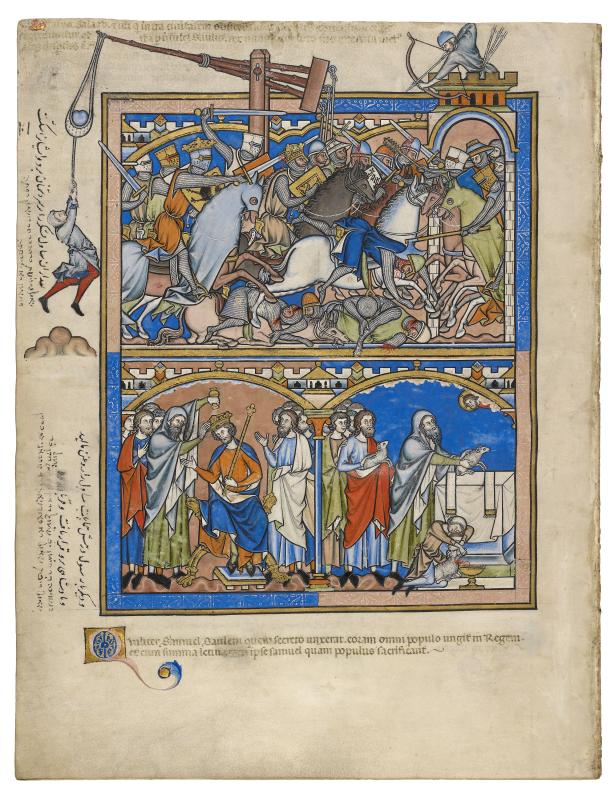
The Crusader Bible, also known as the Morgan Picture Bible, the Maciejowski Bible, and the Shah 'Abbas Bible, is not only one of the greatest medieval manuscripts in the Morgan, it also ranks as one of the incomparable achievements of French Gothic illumination. The miniatures represent one of the greatest visualizations of Old Testament events ever made. Some of the stories and their heroes are well known, but there are also accounts of less familiar Israelites who fought for the Promised Land--tales that resonate to this day. There are incredibly violent battle scenes in which the implements of war are so accurately depicted they could be replicated. And there are scenes of everyday life, love, hate, and envy, as well as adultery, rape, and murder--all set in thirteenth-century France.
Ms. picture book Bible; illuminated in Paris, France?, ca. 1244-1254.
Ms. also known as Crusader Bible, Morgan Crusader Bible, Book of Kings, Kreuzritter Bible, St. Louis Bible, Shah Abbas Bible, and Maciejowski Bible.
Execution of the miniatures has been attributed to 1) France, probably Paris (H. Stahl; D. Weiss, The Book of Kings); 2) northwestern France (A. Stones); 3) England (R. Branner); 4) Flanders or Hainaut (A. Stones), ca. 1244-1254.
There are three other extant folios originally from this manuscript: two in Paris (BnF, Ms n.a.l. 2294 fols 2, 3) and one in Los Angeles (J. Paul Getty Museum Ludwig I 6 - 83.MA.55).
Folios 43r and 43v are sometimes referred to as folios 46r and 46v, respectively. This alternate foliation was assigned to this folio in the Cockerell facsimiles of this manuscript (1927, 1969) as well as Weiss (1998). The facsimiles reconstructed a codex from all extant leaves, combining the Morgan Library's MS M.638 with the three leaves that were previously removed from the codex (see note above). The facsimiles then refoliated this reconstructed codex, which resulted in M.638 folios 43r and 43v being given the folio numbers 46r and 46v. For further information, see Voelkle's Codicological Analysis, as well as the appendix to the Codicological Analysis in Weiss' The Morgan Crusader Bible : The Picture Bible of Saint Louis (1998). The Morgan Library refers to the last folio in M.638 as folios 43r and 43v, not 46r and 46v.
Decoration: 43 leaves illustrated on recto and verso with full-page miniatures in double register compositions subdivided into two halves by a central colonette, representing more than 300 separate episodes.
Quire 1: bifolio fol. 1 and 6, bifolio fol. 2 and 5, bifolio fol. 3 and 4; quire 2: single leaf fol. 7 (with hook around spine), bifolio fol. 8 ans 11, bifolio fol. 9 and 10; quire 3: bifolio fol. 12 and 17, bifolio fol. 13 and 16, bifolio fol. 14 and 15; quire 4: bifolio fol. 18 and 23, bifolio fol. 19 and 22, bifolio fol. 20 and 21; quire 5: bifolio fol. 24 and 29, bifolio fol. 25 and 28, bifolio fol. 26 and 27; quire 6: bifolio fol. 30 and 35, bifolio fol. 31 and 34, bifolio fol. 32 and 33; quire 7: bifolio fol. 36 and 41, bifolio fol. 37 and 40, bifolio fol. 38 and 39; quire 8: bifolio fol. 42 and 43.
Revised: 2015
Crusader Bible
Morgan Crusader Bible
St. Louis Bible
Hungarian Anjou legendary
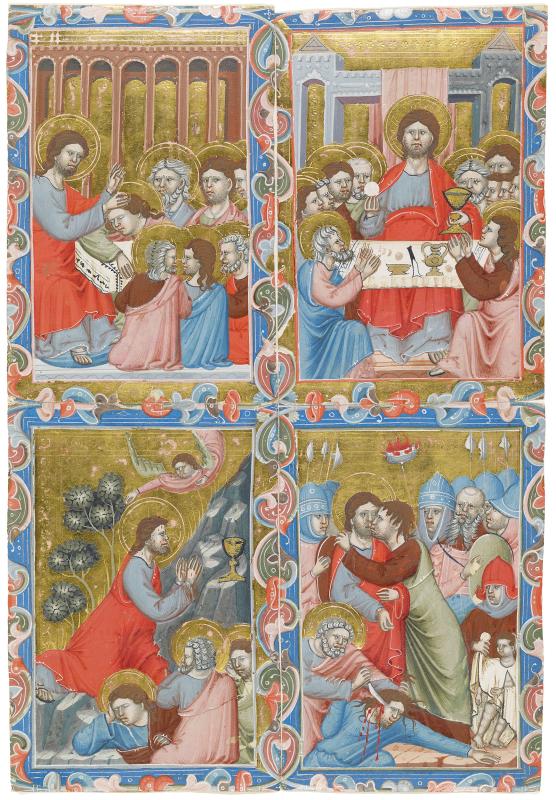
Ms. saints' legends, written and illuminated in Bologna, Italy, or Hungary, ca. 1325-1335.
Decoration: 93 individual images, of which 2 quadripartite miniatures (8 individual images) are in their original format on 2 uncut but marginally cropped leaves (M.360.25, M.360.26); 17 quadripartite miniatures have been fully reconstituted from 68 individual images (cuttings); and 6 quadripartite miniatures have been partially reconstituted from 13 individual images (cuttings). Additionally, M.360.16a-d consists of 4 individual images (cuttings), matted together, from 3 original miniatures.
Artist: Hungarian Master and workshop.
Other known portions of the original Legendary are found in the following collections: 1) Vatican City, Biblioteca Apostolica Vaticana, MS Vat. Lat. 8541 is the largest surviving portion, consisting of 105 leaves with quadripartite miniatures, each section of the miniatures accompanied by a short inscription in Latin. There is no proof that this portion of the Legendary was ever in the hands of Giovanni Battista Saluzzo; a 17th-century foliation indicates that there had been at least 16 additional folios, removed some time between the time of foliation and the binding of this fragment for presentation to pope Benedict XIV (Lambertini, 1740-1758), who gave it to the Museo Cristiano in 1757, and from there it entered the Vatican Library; 2) Leningrad, The Hermitage, MSS E 16930-16934, comprising five cropped leaves of undivided quadripartite miniatures; 3) New York, Metropolitan Museum of Art, MS 199.516; one cropped leaf (219 x 168 mm) of undivided quadripartite miniatures. Provenance: 1630-1642 - Giovanni Battista Saluzzo; 1740-1758 - Pope Benedict XIV [Lambertini]; Gabriele Laureani, Prefect of the Vatican; purchased from Laureani's estate by Giulio Sterbini in 1845; Léonce Rosenberg , Catalogue June-July 1913, #73; next found among the diverse materials of an extra-illustrated first edition of Dibdin's The Bibliographical Decameron owned by Mrs. Walter P. Bliss, New York and Bernardsville, N.J.; her estate sale (New York, Parke Bernet, 12 December 1961 lot 68) to John F. Fleming; purchased ca. 1969 from Fleming by Edwin L. Weisl, Jr. of New York; Edward R. Lubin catalogue: European Illuminated Manuscripts, [1985], no. 18; Gift of Mr. and Mrs. Edwin L. Weisl Jr. to the MMA in 1994; 4) Berkeley, University of California, Bancroft Library, Special Collections, MS 2MS A2M2 1300:37, one cropped leaf of undivided quadripartite miniatures; 5) Paris, Louvre, Cabinet des Dessins, R.F. 29940, one cropped leaf of undivided quadripartite miniatures, 220 x 165 mm., catalogued under "Ecole d'Italie", representing the Legend of St. Francis, a companion to the MMA leaf.
Individual images from M.360.1-24 were previously mounted in a small brown morocco album (preserved in the Morgan Library) by Giovanni Battista Saluzzo (1579-1642) who owned the manuscript in the 17th century. Saluzzo cut apart the leaves, separating them into the four individual units (images) of their original quadripartite format, trimmed off the rubrics and transcribed them onto each verso, and then mounted each individual cutting on a paper folio (85 total), framing it with a paper mat, providing captions in Italian (written above) and Latin (written below). The reconstituted leaves and M.360.25-26 are now matted.
It has been suggested that these surviving miniatures represent no more than two-thirds of their original number, and were probably preceded by a dedicatory and textual section. Of the 59 stories illustrated in the Legendary, 2 are based on Bible texts, 50 are extracted from the standard Legenda aurea and 5 from its Hungarian appendix; for two - the legends of St. Francis and St. Ladislaw - the exact textual precedent is not known. In terms of its organization (as reconstituted in facsimile form), the compiler of the legends eschewed the chronological order of the Church calendar and substituted social structure. The Legendary begins with the stories of Christ and the Virgin, followed by the story of John the Baptist, and then the Apostles, who are presented in the order established in the Litany. In succession come the Martyrs, the Confessors, the Virgins, and finally the Female saints.
Magyar Anjou legendary single leaves
Lectionary

Gospel lectionary, written and illuminated in the Abbey of St. Peter, Salzburg, Austria; ca. 1050.
Decoration: 9 full-page miniatures, 6 illuminated initials, many smaller initials in gold.
Textiles: Some of the initials and miniatures (1v, 2v, 8r, 58v, 80r, 86r, 86v, 100v, 103r) were provided with protective curtains, which may date to the tenth century. These curtains were replaced in 1996 and the originals are now stored separately as G.44a and G.44b.
Miscellany

Ms. written and illuminated in Naples, Italy, in the last quarter of the 14th century.
Texts: Master Matthew, Canon of Linköpins, Sweden, Stupor et mirabilia audita sunt (fol. 1-7v); Saint Bridget of Sweden, Revelationes (fol. 8-327); Alfonso Pecha, Epistola solitarii ad Reges (fol. 328-340); Saint Bridget of Sweden, Liber coelestis imperatoris ad reges (fol. 340v-390v); Sermone angelico de excellentia beatissime virginis (fol. 391-408v); Oratines divinitus revelatae (fol. 409-414).
Pierpont Morgan Library. MS M.498 is manuscript "Y" in the Uppsala publications of the edited works of Saint Bridget of Sweden.
Decoration: 2 full-page miniatures, 12 historiated initials.
Missal

Ms. missal, use of Sarum; written and illuminated in England, perhaps Cambridge, ca. 1320.
Decoration: 19 historiated initials, 615 decorated borders, some historiated; Clavering and Tiptoft arms: quarterly or and gules, with a band dexter sable, and argent, a saltire engrailed gules, in many borders; English Gothic style.
Artist: M.A. Michael attributes M.107 to the artists of the Barlow psalter (Oxford, Bodleian Library, MS Barlow 22) and the Croyland Apocalypse (Cambridge, Magdalene College, MS 5)--Cf. PML files.
Missal
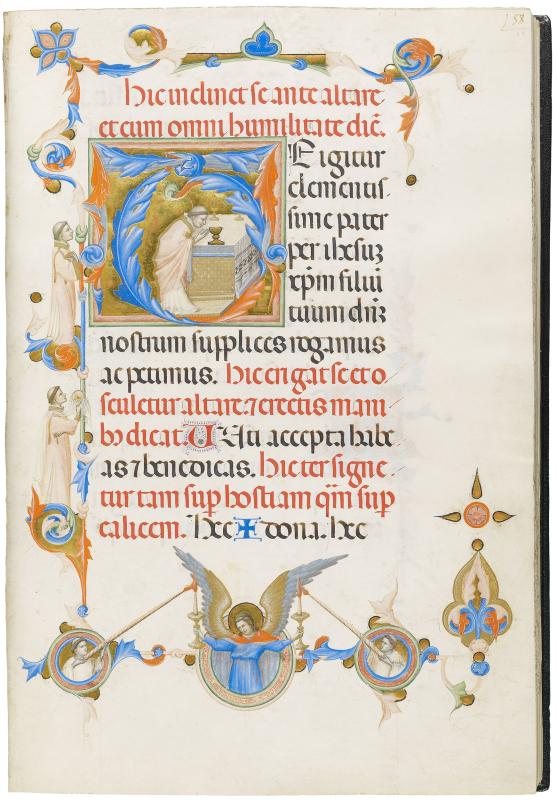
Ms. missal; written and illuminated in Florence, Italy, or in Avignon, France, during the late 1320s.
A colophon on fol. 167v states that this is the seventh and final volume of a missal that contains the Ordinary of the Mass and the main prayers of the missal for the Votive Mass and that there are 19 quinterns and 8 leaves: Septimu(m) volum(en) i(n) missali q(u)o e(st) testam(en)tu(m) misse, & ora(tion)es (m)a(io)res i(n) missali s(cundu)m misse votive, & s(un)t q(ui)nt(er)ni xix, & viii carte.
It has been suggested that this manuscript is one of a codicologically homogenous group created for Cardinal Jacopo Stefaneschi that were copied by the same scribe and illuminated by the same artist--Cf. Dix siècles d'enluminure italianne (VIe-XVIe siècles).
Musical notation: 4-line staves in red ink with square notes throughout.
Decoration: 4 historiated initials, 2 historiated borders.
Artist: Master of the St. George Codex.
Missal

Ms. missal for Franciscan use, with calendar for Angers; written and illuminated in France, possibly Angers, ca. 1427.
Decoration: 8 miniatures; flower and band borders; arms.
Artist: a Nantois artist.
Missal

Ms. missal, Augustinian use; written and illuminated in Perugia, Italy, in the third quarter of the 15th century, and after 1472.
Decoration: 1 full-page miniature, 1 decorative title page with arms in an illuminated border; 17 historiated initials.
Artists: follower of Giacomo Caporali (initials and borders) and Fiorenzo di Lorenzo (miniature on fol. 131v).
Missal

Ms. missal for the use of Rome; written and illuminated in Rome, Italy, ca. 1485.
Ms. formerly considered to have been written and illuminated in Verona, Italy.--Cf. PML files
Pierpont Morgan Library MS M.306 is v. 1 of a four volume missal; the other three volumes are in the Archivio di Stato, Turin (MSS J.II.b.2-4) and were illuminated by the Master of the della Rovere Missals.
Decoration: 2 miniatures; 28 historiated initials.
Artists: Francesco Bettini and the Master of the della Rovere Missals.
Bettini, a Veronese, signed his name as Francesco Betyni on fol. 29r and as Francischus veronensis on fol. 78v. His motto "Ab Olympo" appears on fols. 78v and 118v. He did not participate in the other three volumes of the missal.
The Master of the della Rovere Missals has been tentatively identified with the French illuminator Jacques Ravaud (Jacopo Ravaldi), established in Rome from 1469, who illustrated an opening miniature in the Statuta artis picturae of 1478 of the Confrèrie de Saint-Luc (Rome, Accademia di San Luca, ms. 1). See, B. de Chancel-Bardelot, Tours 1500. Capitale des arts, 2012, 258-261.
The Master of the della Rovere Missals seems to have painted over drawings by Bettini on some folios including 14r, 32v, and 51v.
The text of M.306 is unfinished. The Ordinary of the Mass, including Seasonal Prefaces has not been completed.
Revised: 2016
Missal

Ms. missal for the use of Tours (the feasts, two litanies); written and illuminated in Tours, France, ca. 1500.
The ms. is most recently dated ca. 1500 - 1503. Jean Lemaire de Belges's "La plainte du désiré" of 1503/4, which praises Poyer among famous deceased artists, gives a terminus ante quem for the manuscript.
Artists: Jean Poyer and the Master of Spencer 6; all five large miniatures, one historiated initial, and their borders are by Poyer and the remaining small miniatures are by the Master of Spencer 6.
Reflectography and band pass filters have revealed detailed underdrawings under Poyer's miniatures (Wieck, 2000, p. 32, fig. 23).
Decoration: 5 large miniatures, 18 small miniatures, 1 historiated initial.
Revised: 2015
Missal

Ms. single leaf (composite), matted, in gilt frame; the source of the cuttings is one or more of the Missals of the Sistine Chapel commissioned by either Pople Clement VII or Pope Leo X, illuminated in Rome, 1523.
Border strips contain the devices and monograms of Pope Clement VII (de' Medici).
Decoration: 1 miniature depicting Pope Clement VII asperging the congregation before mass.
Artist: Vincenzo Raimondi.
Missal
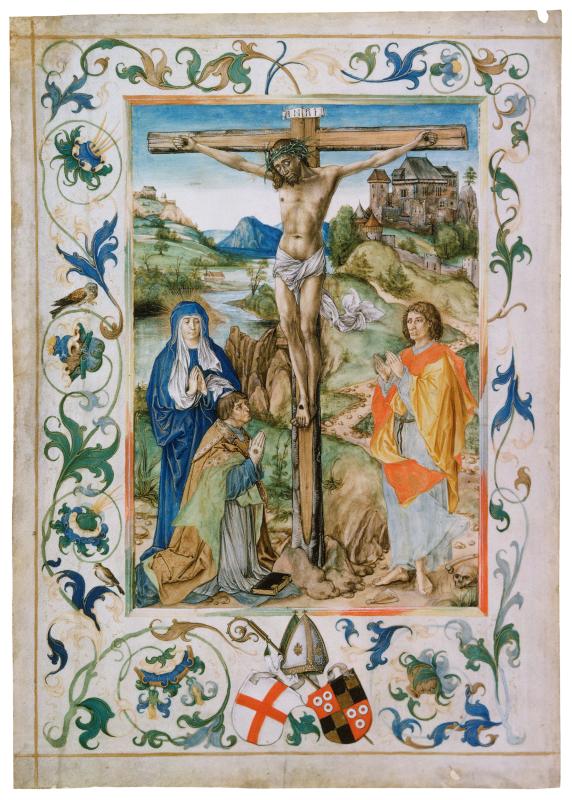
Ms. missal leaf with the Canon of the Mass illustration; written and illuminated in Constance, Germany, ca. 1500.
Decoration: 1 full-page miniature with floral border containing a coat-of-arms: Crucifixion in a landscape with Mary, John, and the donor, Bishop Hugo von Hohenlandenberg (1460-1532), kneeling at the foot of the cross. The miniature has been attributed to Springinklee der Ältere, the postulated father of the illuminator Hans Springinklee (see Merkl 1999, p. 361).
Moralized Bible
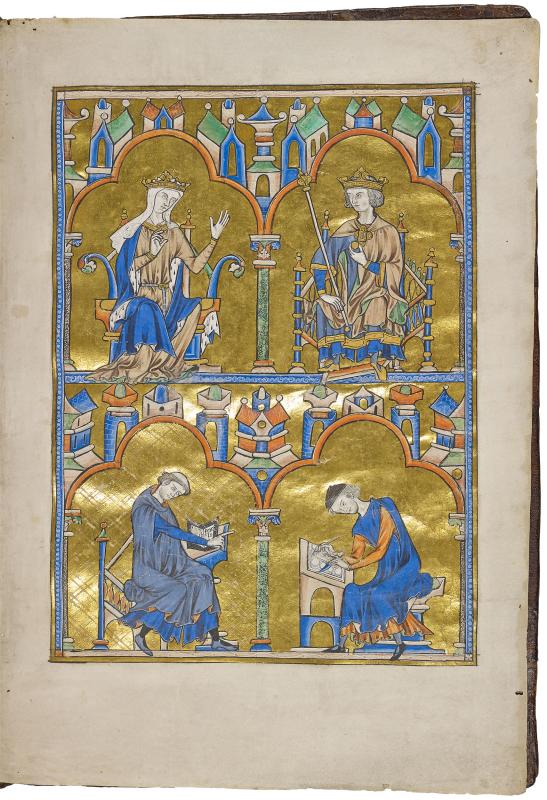
Ms. written and illuminated in Paris, France, between 1227 and 1234.
Decoration: 8 full-page miniatures, all but one with 8 roundels each.
Title on case: Apocalypse, illuminated manuscript
Pontifical

Ms. pontifical for the use of Pope Leo X; written and illuminated in Rome, Italy; dated 1520 on fol. 1v.
Scribe: Federicus.
Decoration: 1 large miniature, 29 historiated initials, 2 historiated borders, 17 borders with emblems or arms.
Artist: Attavante degli Attavanti.
See also collation in a linked document under Detailed descriptions.
Portolan atlas
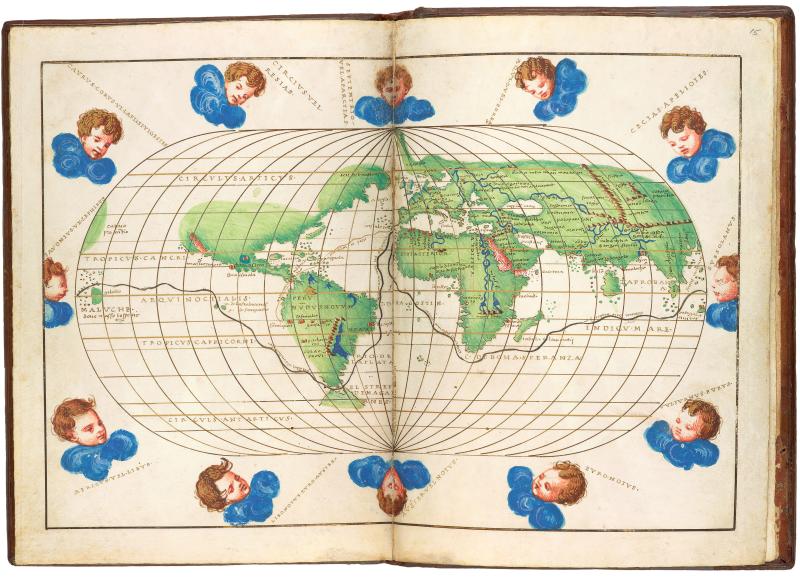
Ms. atlas; written and illuminated in Venice, Italy, in 1542.
Scribe and artist: Battista Agnese; signed and dated on fol. 13v: baptista agnese fecit venetijs 1542 die 15 mai; the windrose is not believed to be by Agnese.
Decoration: 1 illuminated windrose, 1 illuminated zodiacal circle; 1 full-colored world map with 12 blowing wind heads; 9 other maps with details in colors and wash gold.
Prayer book

Ms. prayer book; written and illuminated in Milan, Italy, about 1430.
Collation: I4, II8, III9, IV8, V9, VI7, VII9, VIII6, IX5, X4, XI7, XII8, XIII8, XIV3.
The manuscript is written in dark brown ink by one scribe.
The text comprises 47 prayers arranged liturgically and dedicated to various feasts taken from the Temporal and Sanctoral cycles of the church year.
Decoration: 22 full-page miniatures with floral borders, 1 historiated initial, 47 text pages with borders, 46 illuminated initials; at least half of the original miniatures and parts of the texts are missing.
Artist: Michelino (de' Molinari) da Besozzo.
Prayer book of Anne de Bretagne

Ms. prayer book; written and illuminated in Tours, France, between 1492 and 1495.
Also known as the Prières d'Anne de Bretagne.
Decoration: 34 miniatures framed by her emblem, the cordelière; the letters of the name of Anne fill the borders surrounding the miniatures.
Artist: Jean Poyer (formerly Poyet).
Manuscript commissioned by Anne de Bretagne to teach the dauphin, Charles-Orland, his catechism. Inherited by her daughter Claude de France and used as a model ca. 1515 for the Primer of Renée de France, Claude's younger sister (Modena, Biblioteca Estense Universitaria, MS Lat 614=a.U.2.28).
Folio 31r shows a youth, probably representing Charles-Orland, kneeling, his hands joined and raised in prayer towards God the Father. Behind the youth is a throne.
Revised: 2016
Primer of Charles-Orland
Prayer book of Claude de France

The Prayer Book of Claude de France is a tiny, jewel-like manuscript that was made for Claude (1499-1524) around 1517, the year she was crowned queen of France. Her coat of arms appears on three different folios. The book is richly illustrated: the borders of each leaf are painted, front and back, with 132 scenes from the lives of Christ, the Virgin Mary, and numerous saints. The manuscript and a companion Book of Hours also made for the queen (in a Swiss private collection) were illuminated by an artist who was given the nickname Master of Claude de France after these two volumes. Active in the French city of Tours during the first quarter of the sixteenth century, the artist worked in a style that can be characterized as the pinnacle of elegance. The colors of his delicate palette are applied in tiny, seemingly invisible brushstrokes. Only about a dozen manuscripts painted by the artist survive.
In 1514, at age fourteen, Claude de France was married to François d'Angoulême (1494-1547), who became King François I in 1515. The marriage was political: Claude was duchess of Brittany, a duchy the king wanted to keep under his control. Short and hunched, Claude still managed to provide seven children (her second son became King Henry II) in ten years of marriage before dying of exhaustion at age twenty-four.
The Prayer Book of Claude de France (MS M.1166) is the gift of Mrs. Alexandre P. Rosenberg in memory of her husband Alexandre Paul Rosenberg, 2008.
Ms. prayer book; written and illuminated in Tours, France, ca. 1517.
Decoration: 132 miniatures; the narrative scenes overlapped in trompe-l'oeil by placards carrying the text and almost all framed by the Franciscan cordelière.
Artist: Master of Claude de France (named after this codex and a companion Book of Hours made for the queen, formerly in a private collection in Paris and now owned by the dealer Heribert Tenschert).
The master's identity has been tentatively linked to Eloi Tassart documented in Tours from 1517 to 1528 and called "painter of the queen" from 1521-1523. No works can be definitely ascribed to him however. See R. Wieck, Miracles, p. 58.
A censor's notation was added in Spain in the 16th or 17th century on fol. 53v, " [sign of the cross] vistas licen[tia]tus Roche Inqui[s]i[to]r." See R. Wieck, Miracles, p. 24, 26, fig., 32.
Bookplate of Alexandre Paul Rosenberg designed by Pablo Picasso inside front cover.
Revised: 2016
Prayer book of Queen Claude de France
Claude de France prayer book
Psalter

Ms. psalter single leaf, illuminated at Christ Church Priory (Canterbury, England) between 1155 and 1160.
Part of the Canterbury psalter (the Eadwine psalter); most of the psalter is held by Trinity College, Cambridge University. MS R.17.1.
Pierpont Morgan Library. MS M.724; British Library. MS Add. 37472; and Victoria and Albert Museum. MS 661 are other leaves from this psalter.
Decoration: 2 full-page illuminations (recto and verso) comprising 24 compartments, each with two or more scenes.
Sacramentary

Ms. sacramentary; written and illuminated at the Benediktinerabtei Weingarten between 1215 and 1217.
Musical notation: staveless; neumes on fol. 14v.
Decoration: 21 full-page, 5 half-page, and 2 small miniatures; 6 full-page illuminated texts; 19 historiated initials; numerous decorated initials; many with gold- and silver-leaf, some highly burnished.
Textiles: protective curtains over some of the initials and miniatures.
The manuscript contains numerous emroidered repairs.
Artist: Master of the Berthold Sacramentary.
Sacramentary

Ms. sacramentary, for the Roman rite in a Benedictine monastery; written and illuminated at Mont-Saint-Michel Abbey, in Normandy, ca. 1060.
Forty-five leaves from this manuscript are held in the Bibliothèque municipale in Rouen (MS 116).
Musical notation: primitive neume notation of northern France throughout the manuscript.
Decoration: 12 full-page miniatures and decorative panels; 4 half-page miniatures; 11 panels with decorative initials, 7 smaller historiated initials.
Seated ruler with two women and a saint

Ms. leaf from a medieval manuscript with late 19th or early 20th century illumination.
Text on verso is from the vespers Magnificat for Jan. 7 and begins: videntes stellam.
Decoration: 1 large miniature on recto.
Artist: Spanish Forger.
Single leaf, Gradual

Ms. gradual (perhaps antiphonary) leaf, written and illuminated in Dijon, France, ca. 1536-1537.
Text: on back of miniature is introit of Corpus Christi Mass (or perhaps Lauds Benedictus antiphon) with musical notation: "[E]go sum panis vivis qui".
Decoration: 1 historiated initial C (140 x 140 mm), margin decorated with border of foliate and floreate ornament.
Artist: Master of the Hours of Jean des Bruyères and Jeanne de Recourt (Master Regnault or Oudot Matuchet?).
Single leaf, Laudario of Sant’Agnese
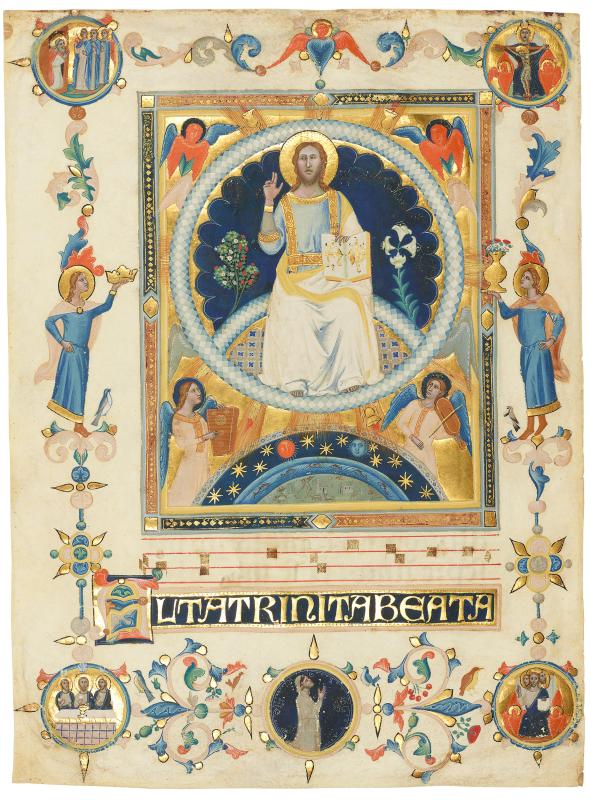
Ms. single leaf from a Laudario (vernacular hymnal); written and illuminated in Florence, Italy, ca. 1340.
Text on the verso is from an unidentified lauda: ...gue et carne pura / in tale speçie avengna / perche sicuri li tuoi servidori / ciascun ci pren[d]a a lliberar la mente / fosti amorosamente / non te mostrando di te largitore / tu quando non secondo quantitade / non fuor di luogo non come locato / ma sempre un cor pose in luoghi diversi...
Pierpont Morgan Library MS M.742 is one of nearly two dozen leaves and cuttings from a single laudario that are scattered among European and American collections, listed and described in Kanter, 1994. Sister leaves (M. 742 is one of 23) -- Washington: National Gallery B-20,651 and B-15,393 and B-22,128; Paris: Musée du Louvre, inv. no. 9828; Philadelphia: Free Library, M. 25:8 and M. 25:7a; Kreuzlingen, Kislers Collection, Adoration of the Magi; London: British Library, Add. MS. 18196 and Add. MS. 35254; Florence: Private Collection, Annunciation; Cambridge: Fitzwilliam Museum, MS 194 and Marlay Cutting It. 83; New York: Private Collection, Ascension; Strasbourg: Forrer Collection, Baptism and Martyrdom of Saint Pancras in inital S; Chicago: Art Institute, Saint Zenobius in inital N; Rome: Salmi Collection, Miracles of Saint Zenobius; New York: Breslauer Collection, 66; Antwerp: van den Bergh Collection, MS 303; New York: private collection, Martyrdom of Saint Bartholomew; The Cloisters Collection (Metropolitan Museum of Art, New York, NY) 2006.250, formerly Florence: Bruscoli Collection, Instruments of the Passion in initial O; Berlin: Staatliche Museen Kupferstichkabinett, Min. 6059
Decoration: 1 large miniature with Christ in Majesty surrounded by full vinescroll border containing 2 full-length offering figures and 5 historiated medallions.
Musical notation: 4-line staves in red ink, square notes.
Artist: Pacino di Bonaguida.
Single leaf, Winchester Bible

Ms. Bible single leaf (from the Winchester Bible); the Bible was illuminated at St. Swithin's Priory, Winchester, England, between 1160 and 1180.
Text: chapter headings from I Samuel XVI to XXVI.
Decoration: 3-register miniatures on recto and verso with a sequence of 17 scenes from the lives of Samuel, Saul, and David.
Artist: the underdrawings are by the Master of the Apocrypha Drawings; painted by the Master of the Morgan Leaf.
Previous scholars have believed that this leaf - the only fully painted miniature from the Winchester Bible known to be preserved - was never inserted in the manuscript. Claire Donovan (The Winchester Bible, 1993) argues that the strong discoloration on the verso of M.619 and on the recto of folio 88 of the Winchester Bible demonstrates that M.619 was indeed inserted and the Bible itself was on display for centuries at this opening, accumulating dust and other pollutants.
Matted.
Morgan Leaf
Speculum humanae salvationis

Ms. written and illuminated in Bruges, Belgium, mid 15th century.
Decoration: 192 miniatures, neat drawings colored in blue, rose, green and grey wash.
Artists: Gold Scrolls Group.
Pierpont Morgan Library MS M.385 is in the Pen and Ink Group, manuscripts, including Pierpont Morgan Library MS M.649, illustrated with pen drawings executed by the Gold Scrolls Group.
Vita Christi (Life of Christ)

Ms. life of Christ picturebook; illuminated in northern France, perhaps Corbie, ca. 1175.
Decoration: 30 full-page miniatures detatched perhaps from a psalter.
Revised: 2015




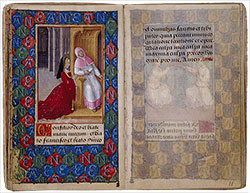

Named after the Abbey of Lindau on Lake Constance (Germany), where it was once housed, the Lindau Gospels ranks as one of the great masterpieces from the collection of the Morgan Library & Museum. Its jeweled covers constitute one of the most important of all medieval treasure bindings. Quite unusually, the manuscript's exquisite covers are in fact from entirely different regions and moments in time. Dating to the late eighth century, the back cover is the earliest component of the book and was likely made in the region around Salzburg (Austria). The front cover, in contrast, dates to nearly a hundred years later (ca. 870-80) and was likely produced in what is today eastern France. The manuscript itself is later still (ca. 880-90), and was certainly written and illuminated in the monastery of St. Gall (Switzerland). At some unknown point in time, precious silks from Byzantium and the Middle East were attached to the inside covers of the manuscript, thus adding yet another layer of complexity to this fascinating object.
The manuscript itself contains the text of the four Gospels along with standard supplementary material, such as the prologues of Jerome, prefaces for each of the Gospels, chapter listings, and twelve richly illuminated canon tables. Clearly inspired by textile designs, the two decorative pages that frame the manuscript's canon tables, are a particularly unusual feature of the manuscript's illumination. Nothing quite like them exists in any other manuscript from the period. As many as seven different scribes were engaged in the copying of the texts, and it is thought that a monk named Folchart--one of St. Gall's preeminent artists--was personally responsible for some of the manuscript's illuminated pages.